Kristin Seaman, Environmental Coordinator, City of Woodbury
After earning her bachelor’s degree in environmental science, policy, and management, Kristin Seaman spent a year in AmeriCorps working on stormwater education and local governance issues. When the COVID-19 pandemic began, she decided to take advantage of the AmeriCorps education award and began looking for online graduate programs. She landed on the Leadership for Science Professionals (LSP) Certificate.
“I was attracted to the spread of courses that were offered,” Kristin says. “My undergrad degree was really focused on science and how people interact with science but not so much of how I interact with the people in science and government.”
She adds, “I chose this program because the title and topics really interested me and sounded really applicable to what I currently do but also what I might do in the future.”
Kristin, who is the Environmental Coordinator for the City of Woodbury, also liked the program’s flexibility and its focus on working adults. Many of her virtual classmates were also balancing a full-time job, and the online format allowed them to complete their coursework on their own schedule.
“It felt almost like a level playing field,” she says. “I would feel guilty or more stressed if I knew my peers were able to spend an extra four hours a day that I just don't have in my schedule. And I felt like the professors have all been really amenable as well.”
The Rewards and Challenges of Protecting Water
Kristin is one of only a handful of people with the title of environmental coordinator for a city or town. She currently monitors the surface water and groundwater for the City of Woodbury and loves the different challenges she gets to tackle.
“Just this week my biggest pressing priorities are the urban tree canopy plan, which is really close to being complete, and the irrigation reuse systems in the city,” she says.
“We're looking at the systems in the city that are connected to or that pull irrigation water out of ponds. We're doing a review to make sure that they're all functioning and connected appropriately.” Kristin is also working on open-space vegetation and native restoration projects, as well as long-term maintenance of restored areas.
But because there are so few environmental professionals stationed in each city, they often have to perform a variety of duties and choose between outcomes.
“My role, and similar roles in other cities, is that we're all trying to do our best for the local community and environment. Unfortunately, because there are so many competing factors in the environmental field, a lot of times different aspects are pitted against each other.”
For example, her goal may be to improve stormwater quality, but the solution might involve removing an existing stand of trees or a plan for additional trees.
“That's tough when you have to pick between two things you really care about. We have both aging infrastructure and new areas that are being approved and constructed, so we have to balance those priorities and concerns.”
The Secret Life of Surface Water
As a kid growing up near Lake Michigan, Kristin was aware of how humans and industry impact natural bodies of water. Now, as a trained environmental scientist, she understands more fully how everything is connected.
“In the City of Woodbury we have something like 900 stormwater ponds, wetlands, constructed ponds, rain gardens, or infiltration basins, and they're all connected through pipes and channels and then to our lakes.”
When people walk their dog and don't pick up after them, she continues, they don't realize that the waste will essentially reach an open body of water through storm drains. That stormwater isn’t treated like the water we use and drink everyday; it just flows directly through channels underground to a lake, a river, or a pond. “It's just being diluted and taking more time to get there,” Kristin says.
Knowing this kind of information makes it hard to look at rain the way the rest of us do. She admits it’s tough to take off her scientist hat.
“I went backpacking to the Grand Canyon a couple of years ago,” she recalls, “and I was amazed by the rock formations. I was thinking about when it does rain, how would it fall on the landscape given the cliffs, trails, and the types of vegetation, and what would that vegetation do with the water? So, yeah, I can't turn it off at all.”
Major Takeaways from the LSP Certificate
- Synergy. “I benefited the most when I saw synergies with the coursework and my job or even things I do outside of work, like volunteering. As you're growing and learning, you're building on your knowledge in practice.”
- Leadership. “It really felt like a good personal challenge (for me) to look at myself and how I fit into the landscape of my work. I think these tools and this experience are going to encourage me to do more, to take that leadership role on a little bit deeper.”
Memorable Course
Legal and Ethical Business Issues for Science Professionals with Shirley Boyd
Pro Tip for Students
"Don’t underestimate how much time your coursework will take, especially if you’re working full time."



